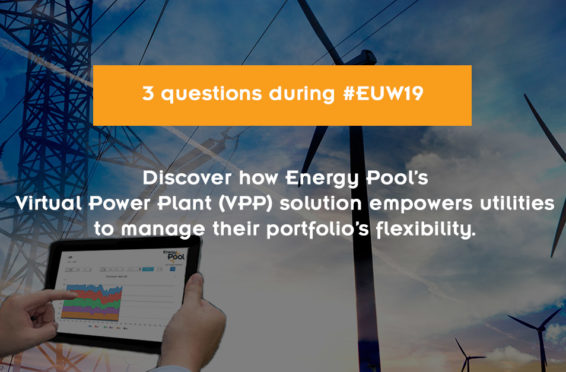Energy Pool, originally a Demand Response (DR) aggregator, has started offering its Virtual Power Plant (VPP) solution 3 years ago. Let’s discover how this solution empowers utilities to manage their portfolio’s flexibility. Paul SANTUS, who manages our software development team, and Baptiste GUILLAUD-ROLLIN, who assists in VPP roll-out projects will answer our questions.
First, could you please remind us the difference between Distributed Energy Resources Management System (DERMS) and Virtual Power Plant (VPP)? Is it relevant to compare them?
PS: It’s all about flexibility! Various authors (see for instance Ranchere’s latest article) discriminate them according to which markets flexibility is being monetized, with DERMS focusing on Grid-balancing programs vs. VPP focusing rather on energy (futures, day-ahead, intraday) markets.
Historically, actors investing in Renewables (which need 24/7 trading, but have little flexibility) are positioned on the latter. While actors in the Demand Response have invested in the former. The emergence of new flexible assets (namely, batteries, but also generation assets used for self-consumption) is likely to push to unification of those solutions.
Energy Pool, with its C&I Demand Response Aggregator background, has a strong expertise in flexibility valorization on TSO programs (which are the most demanding ones) and, with 3 years operations of batteries and CHPs, is swiftly closing the gap on energy-markets monetization.
How could a DERMS/VPP solution be key to contribute to Utilities transformation?
PS: Distributed Energy Resources are being commissioned at a fast pace, and just the hassle of managing so many assets can be a challenge. (Since wind and photovoltaics are mostly non-dispatchable,) Utilities focus towards renewable generation are more used to monitoring generation for imbalance control, than performing active flexibility trading and dispatch.
Furthermore, TSO programs are more and more open to demand/behind-the-meter generation units. Utilities managing portfolios of consumers may not be used to negotiating flexibility contracts and setting up automation (providing real-time monitoring and control) at their customers’ premises. Launching a new flexibility business is often challenging. DERMS/VPP proves very useful when going behind-the-meter to operate assets you don’t own, taking into account other on-site assets consumption, preserving the owner’s economic interest, while getting value from markets, which require the same level of reliability you would get from conventional generation units.
Real value creation comes when Utilities are capable of stacking multiples sources of revenues (TSO markets, from FCR to mFRR or free balancing bids, energy markets – catching price volatility, limiting imbalance fees). Finding the (ever-changing) combination that maximizes revenue. Here, Energy Pool’s aggregation and operation expertise is valuable as well.
Energy Pool already provided major Utilities and large C&I end-users worldwide with its VPP software. What are the key benefits for the software users? What about the time needed to roll-out such solution?
BGR: Well, our software was built over our 10-year experience as a DR aggregator in multiple areas (e.g. 15 programs managed). This means that all functionalities have been designed to meet “real-life operational needs”. They were also improved thanks to direct feedbacks from our on-field-technicians and our customers. Users benefit from a proven technology that we use for being successful on our own operations.
Our system is also very scalable and flexible. It’s an end-to-end solution, which can be delivered under separated modules, customized to meet each specific customers’ need.
Among a wide range of functionalities, there are features to analyze and model asset flexibilities. Monitoring and forecast technology are also available. It also includes a powerful optimizer for flexibilities aggregation and dispatch. Finally, our Utilities clients and their customers can access to an online portal gathering all information (M&V report, operation’ performance, revenues etc.) related to flexibility programs they participate in. Each module is activated according to our clients needs.
Finally, technical and functional updates are delivered regularly in order to remain at the state of the art. Our platform also complies with most standardized protocols (OpenADR, IEC’s Common Information Model, as well as industrial protocols), integration with our clients system is facilitated by APIs.
How hard is it to roll-out Energy Pool Virtual Power Plant (VPP) solution?
BGR: Our software is a cloud-based solution allowing a fast and cost-effective deployment. We provide our client with a step-by-step implementation and a specific training. Doing so, Utilities sales teams become capable of presenting their customers with flexibility valorization offers in a very short time. For instance, one of our client was able to participate in a national emergency reserve program in just three months.
A key enabler for fast deployment is also Energy Pool’s telecontrol solution, called Flex-Box. Flex-Boxes ensures secured and reliable communication with flexible assets and are really easy to install and configure. Note that we can also connect with existing automation devices.

Finally, the platform users can rely on a very pro-active support team. Our team is reachable 24/7 through an efficient ticketing system and hotline!
Interested in getting further information on Energy Pool services and solution? Join us on European Utility Week booth G57 or contact us today.

